Romanian language
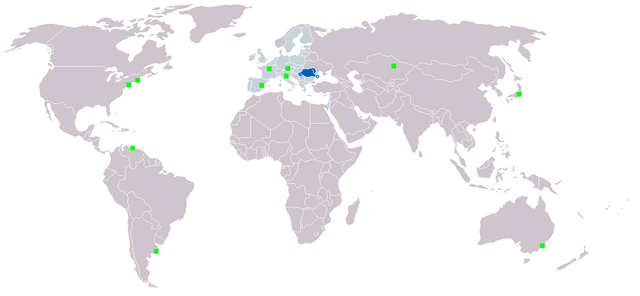
Romanian language

| Romanian | |
|---|---|
| Daco-Romanian | |
| limba română | |
| Pronunciation | |
| Native to | Romania,Moldova |
| Ethnicity | Romanians(incl.Moldovans) |
| 24–26 million (2016)[2]Second language: 4 million[3]L1 | |
| Dialects | |
| Latin(Romanian alphabet)Cyrillic(Transnistriaonly)Romanian Braille | |
| Official status | |
| Romania MoldovaVojvodina(Serbia) | |
| Regulated by | Romanian AcademyAcademy of Sciences of Moldova |
| Language codes | |
| Glottolog | [4] |
| Linguasphere | |
Romanian (dated Rumanian or Roumanian; autonym: limba română [ˈlimba roˈmɨnə] ( listen), "the Romanian language", or românește, lit. "in Romanian") is a Balkan Romance language spoken by approximately 24–26 million people[5][6] as a native language, primarily in Romania and Moldova, and by another 4 million people as a second language.[7][8] It is an official and national language of each of Romania and Moldova. In addition, it is also one of the official languages of the European Union.
Romanian is a part of the Eastern Romance sub-branch of Romance languages, a linguistic group that evolved from several dialects of Vulgar Latin, which was separated from the Western Romance during the 5th–8th centuries.[9] To distinguish it within that group in comparative linguistics it is called Daco-Romanian as opposed to its closest relatives, Aromanian, Megleno-Romanian, and Istro-Romanian. Romanian is also known as Moldovan in Moldova, although the Constitutional Court of Moldova ruled in 2013 that "the official language of the republic is Romanian".[1]
Numerous immigrant Romanian speakers are also scattered across many other regions and countries worldwide, with large populations in Italy, Spain, Germany, Russia and the United States.
| Romanian | |
|---|---|
| Daco-Romanian | |
| limba română | |
| Pronunciation | |
| Native to | Romania,Moldova |
| Ethnicity | Romanians(incl.Moldovans) |
| 24–26 million (2016)[2]Second language: 4 million[3]L1 | |
| Dialects | |
| Latin(Romanian alphabet)Cyrillic(Transnistriaonly)Romanian Braille | |
| Official status | |
| Romania MoldovaVojvodina(Serbia) | |
| Regulated by | Romanian AcademyAcademy of Sciences of Moldova |
| Language codes | |
| Glottolog | [4] |
| Linguasphere | |
History
Prehistory
Romanian descended from the Vulgar Latin spoken in the Roman provinces of Southeastern Europe.[10] Roman inscriptions show that Latin was primarily used to the north of the so-called Jireček Line (a hypothetical boundary between the predominantly Latin- and Greek-speaking territories of the Balkan Peninsula in the Roman Empire), but the exact territory where Proto-Romanian (or Common Romanian) developed cannot certainly be determined.[10][11] Most regions where Romanian is now widely spoken—Bessarabia, Bukovina, Crișana, Maramureș, Moldova, and significant parts of Muntenia—were not incorporated in the Roman Empire.[12] Other regions—Banat, western Muntenia, Oltenia and Transylvania—formed the Roman province of Dacia Traiana for about 170 years.[12] According to the "continuity" theory, modern Romanian is the direct descendant of the Latin dialect of Dacia Traiana and developed primarily in the lands now forming Romania; the concurring "immigrationist" theory maintains that Proto-Romanian was spoken in the lands to the south of the Danube and Romanian-speakers settled in most parts of modern Romania only centuries after the fall of the Roman Empire.[10][12]
Most scholars agree that two major dialects developed from Common Romanian by the 10th century.[10] Daco-Romanian (the official language of Romania and Moldova) and Istro-Romanian (a language spoken by no more than 2,000 people in Istria) descended from the northern dialect.[10] Two other languages, Aromanian and Megleno-Romanian, developed from the southern version of Common Romanian.[10] These two languages are now spoken in lands to the south of the Jireček Line.[12]
Early history
The use of the denomination Romanian (română) for the language and use of the demonym Romanians (Români) for speakers of this language predates the foundation of the modern Romanian state. Although the followers of the former Romanian voievodships used to designate themselves as "Ardeleni" (or "Ungureni"), "Moldoveni" or "Munteni", the name of "rumână" or "rumâniască" for the Romanian language itself is attested earlier, during the 16th century, by various foreign travelers into the Carpathian Romance-speaking space,[13] as well as in other historical documents written in Romanian at that time such as Cronicile Țării Moldovei (The Chronicles of the land of Moldova) by Grigore Ureche.
An attested reference to Romanian comes from a Latin title of an oath made in 1485 by the Moldavian Prince Stephen the Great to the Polish King Casimir, in which it is reported that "Haec Inscriptio ex Valachico in Latinam versa est sed Rex Ruthenica Lingua scriptam accepta" - This Inscription was translated from Valachian (Romanian) into Latin, but the King has received it written in the Ruthenian language (Slavic).[14][15]
In 1534, Tranquillo Andronico notes: "Valachi nunc se Romanos vocant" (The Wallachians are now calling themselves Romans).[16] Della Valle Francesco della Valle writes in 1532 that Romanians are calling themselves Romans in their own language, and he subsequently quotes the expression: "Știi Românește?" (Do you know Romanian?).[17]
After travelling through Wallachia, Moldavia and Transylvania Ferrante Capecci accounts in 1575 that the indigenous population of these regions call themselves "românești" ("romanesci").[18]
Pierre Lescalopier writes in 1574 that those who live in Moldavia, Wallachia and the vast part of Transylvania, "se consideră adevărați urmași ai romanilor și-și numesc limba "românește", adică romana" (they consider themselves as the descendants of the Romans and they name their language Romanian).[19]
The Croatian prelate and diplomat Antun Vrančić recorded in 1570 that "Vlachs in Transylvania, Moldavia and Wallachia designate themselves as "Romans" [22] and the Transylvanian Hungarian Martin Szentiványi in 1699 quotes the following: «Si noi sentem Rumeni» ("Și noi suntem români" – "We are Romans as well") and «Noi sentem di sange Rumena» ("Noi suntem de sânge român" – We are of Roman blood).[23] Notably, Szentiványi used Italian-based spellings to try to write the Romanian words.
In Palia de la Orăștie (1582) stands written ".[...] că văzum cum toate limbile au și înfluresc întru cuvintele slăvite a lui Dumnezeu numai noi românii pre limbă nu avem. Pentru aceia cu mare muncă scoasem de limba jidovească si grecească si srâbească pre limba românească 5 cărți ale lui Moisi prorocul si patru cărți și le dăruim voo frați rumâni și le-au scris în cheltuială multă... și le-au dăruit voo fraților români,... și le-au scris voo fraților români"* [24] and in Letopisețul Țării Moldovei written by the Moldavian chronicler Grigore Ureche we can read:* «În Țara Ardialului nu lăcuiesc numai unguri, ce și sași peste seamă de mulți și români peste tot locul...»* ("In Transylvania there live not solely Hungarians or Saxons, but overwhelmingly many Romanians everywhere around.").[25]
Nevertheless, the oldest extant document written in Romanian remains Neacșu's letter (1521) and was written using Cyrillic letters (which remained in use up until the late 19th century). There are no records of any other documents written in Romanian from before 1521.
Miron Costin, in his De neamul moldovenilor (1687), while noting that Moldavians, Wallachians, and the Romanians living in the Kingdom of Hungary have the same origin, says that although people of Moldavia call themselves Moldavians, they name their language Romanian (românește) instead of Moldavian (moldovenește).[26]
Dimitrie Cantemir, in his Descriptio Moldaviae (Berlin, 1714), points out that the inhabitants of Moldavia, Wallachia and Transylvania spoke the same language. He notes, however, some differences in accent and vocabulary.[27] Cantemir's work provides one of the earliest histories of the language, in which he notes, like Ureche before him, the evolution from Latin and notices the Greek and Polish borrowings. Additionally, he introduces the idea that some words must have had Dacian roots. Cantemir also notes that while the idea of a Latin origin of the language was prevalent in his time, other scholars considered it to have derived from Italian.
The slow process of Romanian establishing itself as an official language, used in the public sphere, in literature and ecclesiastically, began in the late 15th century and ended in the early decades of the 18th century, by which time Romanian had begun to be regularly used by the Church.
The oldest Romanian texts of a literary nature are religious manuscripts (Codicele Voroneţean, Psaltirea Scheiană), translations of essential Christian texts. These are considered either propagandistic results of confessional rivalries, for instance between Lutheranism and Calvinism, or as initiatives by Romanian monks stationed at Peri Monastery in Maramureş to distance themselves from the influence of the Mukacheve eparchy in Ukraine.[28]
The language remains poorly attested during the Early Modern period.
Modern history of Romanian in Bessarabia
The first Romanian grammar was published in Vienna in 1780.[29] Following the annexation of Bessarabia by Russia (after 1812), Moldavian was established as an official language in the governmental institutions of Bessarabia, used along with Russian,[30] The publishing works established by Archbishop Gavril Bănulescu-Bodoni were able to produce books and liturgical works in Moldavian between 1815–1820.[31]
The linguistic situation in Bessarabia from 1812 to 1918 was the gradual development of bilingualism. Russian continued to develop as the official language of privilege, whereas Romanian remained the principal vernacular.
The period from 1905 to 1917 was one of increasing linguistic conflict, with the re-awakening of Romanian national consciousness.
In 1905 and 1906, the Bessarabian zemstva asked for the re-introduction of Romanian in schools as a "compulsory language", and the "liberty to teach in the mother language (Romanian language)". At the same time, Romanian-language newspapers and journals began to appear, such as Basarabia (1906), Viața Basarabiei (1907), Moldovanul (1907), Luminătorul (1908), Cuvînt moldovenesc (1913), Glasul Basarabiei (1913). From 1913, the synod permitted that "the churches in Bessarabia use the Romanian language". Romanian finally became the official language with the Constitution of 1923.
Historical grammar
Romanian has preserved a part of the Latin declension, but whereas Latin had six cases, from a morphological viewpoint, Romanian has only five: the nominative, accusative, genitive, dative, and marginally the vocative. Romanian nouns also preserve the neuter gender, although instead of functioning as a separate gender with its own forms in adjectives, the Romanian neuter became a mixture of masculine and feminine. The verb morphology of Romanian has shown the same move towards a compound perfect and future tense as the other Romance languages. Compared with the other Romance languages, during its evolution, Romanian simplified the original Latin tense system in extreme ways,[32] in particular the absence of sequence of tenses.[33]
Geographic distribution
| Country | Speakers (%) | Speakers (native) | Country Population |
|---|---|---|---|
| World | |||
| World | 0.33% | 23,623,890 | 7,035,000,000 |
| official: | |||
| Countries where Romanian is anofficial language | |||
| Romania | 90.65% | 17,263,561[34] | 19,043,767 |
| Moldova2 | 76.4% | 2,588,355 | 3,388,071 |
| Transnistria(Eastern Moldova)3 | 31.9% | 177,050 | 555,500 |
| Vojvodina(Serbia) | 1.32% | 29,512 | 1,931,809 |
| minority regional co-official language: | |||
| Ukraine5 | 0.8% | 327,703 | 48,457,000 |
| not official: | |||
| Other neighboring European states (except forCISwhere Romanian is not official) | |||
| Hungary | 0.14% | 13,886[35] | 9,937,628 |
| Central Serbia | 0.4% | 35,330 | 7,186,862 |
| Bulgaria | 0.06% | 4,575[36] | 7,364,570 |
| Other countries in Europe (except forCIS) | |||
| Italy | 1.86% | 1,131,839[37] | 60,795,612 |
| Spain | 1.7% | 798,104[38] | 46,661,950 |
| Germany | 0.2% | 300,000[39] | 81,799,600 |
| United Kingdom | 0.115% | 67,586[40] | 58,789,194 |
| Portugal | 0.50% | 52,898[41] | 10,561,614 |
| France | 0.07% | 50,000[42] | 65,350,000 |
| Belgium | 0.45% | 45,877[43] | 10,296,350 |
| Austria | 0.45% | 36,000[44] | 8,032,926 |
| Greece | 0.36% | 35,295[45] | 9,903,268 |
| Cyprus | 2.91% | 24,376[46] | 838,897 |
| Ireland | 0.45% | 20,625[47] | 4,588,252 |
| Rest of Europe | 0.07% | 75,000[48] | 114,050,000 |
| CIS | |||
| not official: | |||
| Russia1 | 0.12% | 159,601[49] | 142,856,536 |
| Kazakhstan1 | 0.1% | 14,666 | 14,953,126 |
| Asia | |||
| Israel | 2.86% | 208,400 | 7,412,200 |
| UAE | 0.1% | 5,000 | 4,106,427 |
| Singapore | 0.02% | 1,400 | 5,535,000 |
| Japan | 0.002% | 2,185 | 126,659,683 |
| South Korea | 0.0006% | 300 | 50,004,441 |
| China | 0.0008% | 12,000 | 1,376,049,000 |
| The Americas | |||
| not official: | |||
| United States | 0.10% | 340,000 | 315,091,138 |
| Canada | 0.34% | 110,000 | 32,207,113 |
| Argentina | 0.03% | 13,000 | 40,117,096 |
| Venezuela | 0.036% | 10,000 | 27,150,095 |
| Brazil | 0.002% | 4,000 | 190,732,694 |
| Oceania | |||
| not official: | |||
| Australia | 0.09% | 10,897[50] | 21,507,717 |
| New Zealand | 0.08% | 3,100 | 4,027,947 |
| Africa | |||
| not official: | |||
| South Africa | 0.007% | 3,000 | 44,819,778 |
| 1Many are Moldavian who were deported2Data only for the districts on the right bank of Dniester (without Transnistria and the city of Tighina).In Moldova, it is sometimes referred to as the "Moldovan language"3In Transnistria, it is officially called "Moldovan language" and is written inMoldovan Cyrillic alphabet.4Officially divided into Vlachs and Romanians5Most in Northern Bukovina and Southern Bessarabia; according to aMoldova Noastrăstudy (based on the latest Ukrainian census).[51] | |||
Romanian is spoken mostly in Central and the Balkan region of Southern Europe, although speakers of the language can be found all over the world, mostly due to emigration of Romanian nationals and the return of immigrants to Romania back to their original countries. Romanian speakers account for 0.5% of the world's population,[52] and 4% of the Romance-speaking population of the world.[53]
Romanian is the single official and national language in Romania and Moldova, although it shares the official status at regional level with other languages in the Moldovan autonomies of Gagauzia and Transnistria. Romanian is also an official language of the Autonomous Province of Vojvodina in Serbia along with five other languages. Romanian minorities are encountered in Serbia (Timok Valley), Ukraine (Chernivtsi and Odessa oblasts), and Hungary (Gyula). Large immigrant communities are found in Italy, Spain, France, and Portugal.
In 1995, the largest Romanian-speaking community in the Middle East was found in Israel, where Romanian was spoken by 5% of the population.[54][55] Romanian is also spoken as a second language by people from Arabic-speaking countries who have studied in Romania. It is estimated that almost half a million Middle Eastern Arabs studied in Romania during the 1980s.[56] Small Romanian-speaking communities are to be found in Kazakhstan and Russia. Romanian is also spoken within communities of Romanian and Moldovan immigrants in the United States, Canada and Australia, although they do not make up a large homogeneous community statewide.
Legal status
In Romania
According to the Constitution of Romania of 1991, as revised in 2003, Romanian is the official language of the Republic.[57]
In Moldova
Romanian is the official language of the Republic of Moldova.
The 1991 Declaration of Independence names the official language Romanian.[61][62] The Constitution of Moldova names the state language of the country Moldovan. In December 2013, a decision of the Constitutional Court of Moldova ruled that the Declaration of Independence takes precedence over the Constitution and the state language should be called Romanian.[1]
Scholars agree that Moldovan and Romanian are the same language, with the glottonym "Moldovan" used in certain political contexts.[64] It has been the sole official language since the adoption of the Law on State Language of the Moldavian SSR in 1989.[65] This law mandates the use of Moldovan in all the political, economical, cultural and social spheres, as well as asserting the existence of a "linguistic Moldo-Romanian identity".[66] It is also used in schools, mass media, education and in the colloquial speech and writing. Outside the political arena the language is most often called "Romanian". In the breakaway territory of Transnistria, it is co-official with Ukrainian and Russian.
In the 2014 census, out of the 2,804,801 people living in Moldova, 24% (652,394) stated Romanian as their most common language, whereas 56% stated Moldovan. While in the urban centers speakers are split evenly between the two names (with the capital Chișinău showing a strong preference for the name "Romanian", i.e. 3:2), in the countryside hardly a quarter of Romanian/Moldovan speakers indicated Romanian as their native language.[67] Unofficial results of this census first showed a stronger preference for the name Romanian, however the initial reports were later dismissed by the Institute for Statistics, which led to speculations in the media regarding the forgery of the census results.[68]
In Vojvodina, Serbia
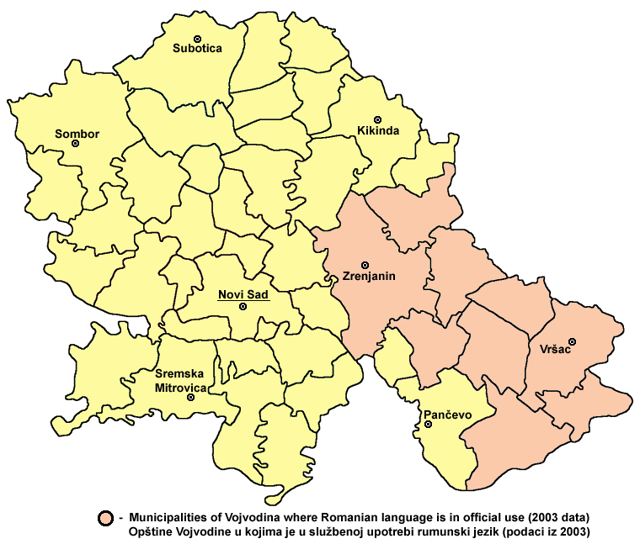
Official usage of Romanian language in Vojvodina, Serbia
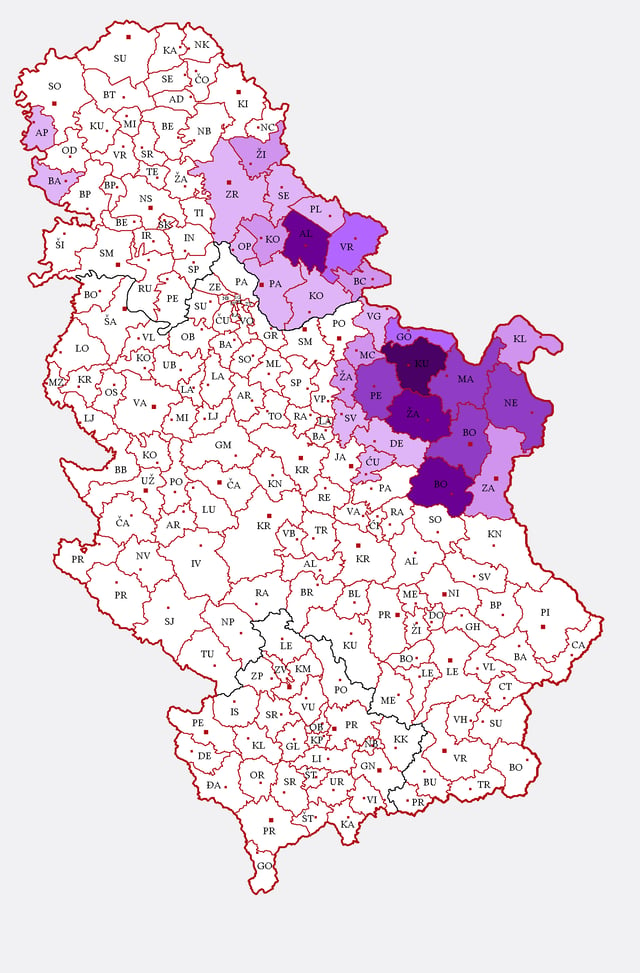
Romanian language in entire Serbia Romanians of Serbia)
The Constitution of the Republic of Serbia determines that in the regions of the Republic of Serbia inhabited by national minorities, their own languages and scripts shall be officially used as well, in the manner established by law.[69]
The Statute of the Autonomous Province of Vojvodina determines that, together with the Serbian language and the Cyrillic script, and the Latin script as stipulated by the law, the Croat, Hungarian, Slovak, Romanian and Rusyn languages and their scripts, as well as languages and scripts of other nationalities, shall simultaneously be officially used in the work of the bodies of the Autonomous Province of Vojvodina, in the manner established by the law.[70] The bodies of the Autonomous Province of Vojvodina are: the Assembly, the Executive Council and the Provincial administrative bodies.[71]
The Romanian language and script are officially used in eight municipalities: Alibunar, Bela Crkva (Romanian: Biserica Albă), Žitište (Zitiște), Zrenjanin (Zrenianin), Kovačica (Kovăcița), Kovin (Cuvin), Plandište (Plandiște) and Sečanj. In the municipality of Vršac (Vârșeț), Romanian is official only in the villages of Vojvodinci (Voivodinț), Markovac (Marcovăț), Straža (Straja), Mali Žam (Jamu Mic), Malo Središte (Srediștea Mică), Mesić (Mesici), Jablanka, Sočica (Sălcița), Ritiševo (Râtișor), Orešac (Oreșaț) and Kuštilj (Coștei).[72]
In the 2002 Census, the last carried out in Serbia, 1.5% of Vojvodinians stated Romanian as their native language.
Regional language status in Ukraine
In parts of Ukraine where Romanians constitute a significant share of the local population (districts in Chernivtsi, Odessa and Zakarpattia oblasts) Romanian is taught in schools as a primary language and there are Romanian-language newspapers, TV, and radio broadcasting.[73][74] The University of Chernivtsi in western Ukraine trains teachers for Romanian schools in the fields of Romanian philology, mathematics and physics.[75]
In Hertsa Raion of Ukraine as well as in other villages of Chernivtsi Oblast and Zakarpattia Oblast, Romanian has been declared a "regional language" alongside Ukrainian as per the 2012 legislation on languages in Ukraine.
In other countries and organizations
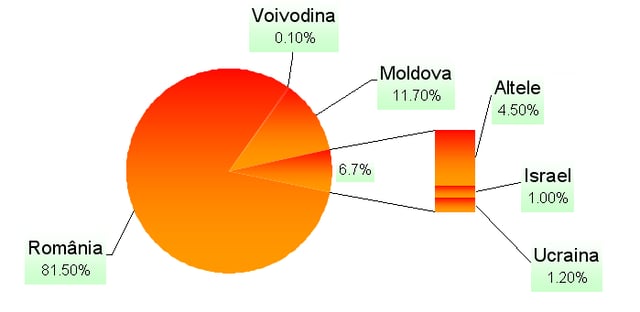
Distribution of first-language native Romanian speakers by country—Voivodina is an autonomous province of northern Serbia bordering Romania, while Altele means "Other"
Romanian is an official or administrative language in various communities and organisations, such as the Latin Union and the European Union. Romanian is also one of the five languages in which religious services are performed in the autonomous monastic state of Mount Athos, spoken in the monk communities of Prodromos and Lacu. In the unrecognised state of Transnistria, Moldovan is one of the official languages. However, unlike all other dialects of Romanian, this variety of Moldovan is written in Cyrillic Script.
As a second and foreign language
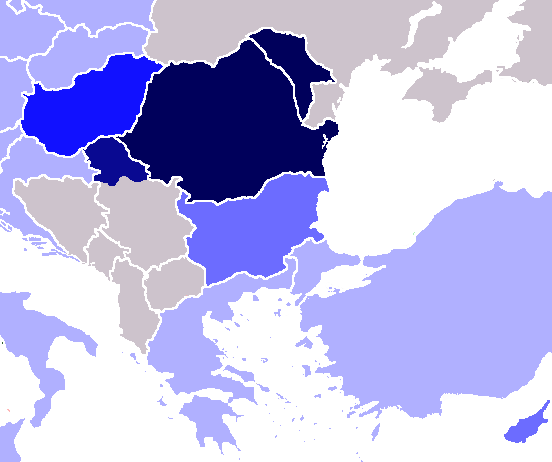
Romanian as second and/or foreign language in Central/Eastern Europe native above 3% between 1–3% under 1% n/a
Romanian is taught in some areas that have Romanian minority communities, such as Vojvodina in Serbia, Bulgaria, Ukraine and Hungary. The Romanian Cultural Institute (ICR) has since 1992 organised summer courses in Romanian for language teachers.[76] There are also non-Romanians who study Romanian as a foreign language, for example the Nicolae Bălcescu High-school in Gyula, Hungary.
Romanian is taught as a foreign language in tertiary institutions, mostly in European countries such as Germany, France and Italy, and the Netherlands, as well as in the United States. Overall, it is taught as a foreign language in 43 countries around the world.[77]
Popular culture
Romanian has become popular in other countries through movies and songs performed in the Romanian language.
Examples of Romanian acts that had a great success in non-Romanophone countries are the bands O-Zone (with their No. 1 single Dragostea Din Tei/Numa Numa across the world in 2003–2004), Akcent (popular in the Netherlands, Poland and other European countries), Activ (successful in some Eastern European countries), DJ Project (popular as clubbing music) SunStroke Project (known by viral video "Epic sax guy") and Alexandra Stan (worldwide no.1 hit with "Mr. Saxobeat)" and Inna as well as high-rated movies like 4 Months, 3 Weeks and 2 Days, The Death of Mr. Lazarescu, 12:08 East of Bucharest or California Dreamin' (all of them with awards at the Cannes Film Festival).
Also some artists wrote songs dedicated to the Romanian language.
The multiplatinum pop trio O-Zone (originally from Moldova) released a song called "Nu mă las de limba noastră" ("I won't forsake our language"). The final verse of this song, Eu nu mă las de limba noastră, de limba noastră cea română is translated in English as "I won't forsake our language, our Romanian language". Also, the Moldovan musicians Doina and Ion Aldea Teodorovici performed a song called "The Romanian language".
Dialects
Romanian[78] encompasses four varieties: (Daco-)Romanian, Aromanian, Megleno-Romanian, and Istro-Romanian with Daco-Romanian being the standard variety. The origin of the term "Daco-Romanian" can be traced back to the first printed book of Romanian grammar in 1780,[29] hasize its origin and its area of use, which includes the former Roman province of Dacia, although it is spoken also south of the Danube, in Dobrudja, Central Serbia and northern Bulgaria.
This article deals with the Romanian (i.e. Daco-Romanian) language, and thus only its dialectal variations are discussed here.
The differences between the regional varieties are small, limited to regular phonetic changes, few grammar aspects, and lexical particularities.
There is a single written standard (literary) Romanian language used by all speakers, regardless of region.
Like most natural languages, Romanian dialects are part of a dialect continuum. The dialects of Romanian are also referred to as subdialects and are distinguished primarily by phonetic differences. Romanians themselves speak of the differences as accents or speeches (in Romanian: accent or grai).[79]
Depending on the criteria used for classifying these dialects, fewer or more are found, ranging from 2 to 20, although the most widespread approaches give a number of five dialects.
These are grouped into two main types, southern and northern, further divided as follows:
The southern type has only one member: the Wallachian dialect, spoken in the southern part of Romania, in the historical regions of Muntenia, Oltenia and the southern part of Northern Dobruja, but also extending in the southern parts of Transylvania.
The northern type consists of several dialects: the Moldavian dialect, spoken in the historical region of Moldavia, now split among Romania, the Republic of Moldova, and Ukraine (Bukovina and Bessarabia), as well as northern part of Northern Dobruja; the Banat dialect, spoken in the historical region of Banat, including parts of Serbia; a group of finely divided and transition-like Transylvanian varieties, among which two are most often distinguished, those of Crișana and Maramureș.
Over the last century, however, regional accents have been weakened due to mass communication and greater mobility.
Classification
Romance language
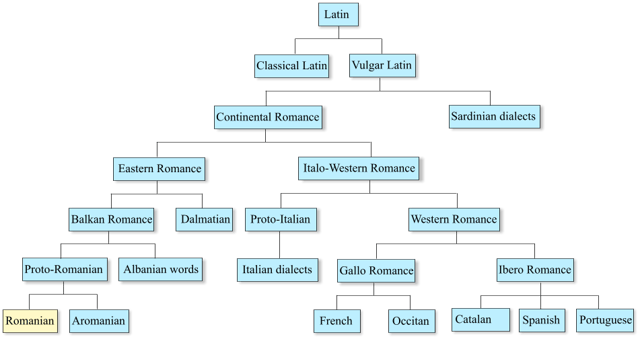
Romanian language in the Romance language family
Romanian is a Romance language, belonging to the Italic branch of the Indo-European language family, having much in common with languages such as French, Italian, Spanish and Portuguese.[80]
However, the languages closest to Romanian are the other Balkan Romance languages, spoken south of the Danube: Aromanian, Megleno-Romanian and Istro-Romanian. An alternative name for Romanian used by linguists to disambiguate with the other Balkan Romance languages is "Daco-Romanian", referring to the area where it is spoken (which corresponds roughly to the onetime Roman province of Dacia).
Compared with the other Romance languages, the closest relative of Romanian is Italian;[80] the two languages show a limited degree of asymmetrical mutual intelligibility, especially in their cultivated forms: speakers of Romanian seem to understand Italian more easily than the other way around. Romanian has obvious grammatical and lexical similarities with French, Catalan, Spanish and Portuguese, with a high phonological similarity with Portuguese in particular; however, it is not mutually intelligible with them to any practical extent. Romanian speakers will usually need some formal study of basic grammar and vocabulary before being able to understand more than individual words and simple sentences in other Romance languages. The same is true for speakers of these languages trying to understand Romanian. Because of its separation from the other Romance languages, it has diverged from them and is an outlier in various ways, somewhat like English in regards to the other Germanic languages.
Romanian has had a greater share of foreign influence than some other Romance languages such as Italian in terms of vocabulary and other aspects.
A study conducted by Mario Pei in 1949 which analyzed the degree of differentiation of languages from their parental language (in the case of Romance languages to Latin comparing phonology, inflection, discourse, syntax, vocabulary, and intonation) produced the following percentages (the higher the percentage, the greater the distance from Latin):[81]
Sardinian: 8%
Italian: 12%
Spanish: 20%
Romanian: 23.5%
Occitan: 25%
Portuguese: 31%
French: 44%
The lexical similarity of Romanian with Italian has been estimated at 77%, followed by French at 75%, Sardinian 74%, Catalan 73%, Portuguese and Rhaeto-Romance 72%, Spanish 71%.[82]
The Romanian vocabulary became predominantly influenced by French and, to a lesser extent, Italian in the nineteenth and early twentieth centuries.[83]
Balkan language area
The Dacian language was an Indo-European language spoken by the ancient Dacians, mostly north of the Danube river but also in Moesia and other regions south of the Danube. It may have been the first language to influence the Latin spoken in Dacia, but little is known about it. Dacian is usually considered to have been a northern branch of the Thracian language, and, like Thracian, Dacian was a satem language.
About 300 words found only in Romanian or with a cognate in the Albanian language may be inherited from Dacian (for example: barză "stork", balaur "dragon", mal "shore", brânză "cheese"). Some of these possibly Dacian words are related to pastoral life (for example, brânză "cheese"). Some linguists and historians have asserted that Albanians are Dacians who were not Romanized and migrated southward.[84]
While most of Romanian grammar and morphology are based on Latin, there are some features that are shared only with other languages of the Balkans and not found in other Romance languages.
The shared features of Romanian and the other languages of the Balkan language area (Bulgarian, Macedonian, Albanian, Greek, and Serbian) include a suffixed definite article, the syncretism of genitive and dative case and the formation of the future and the alternation of infinitive with subjunctive constructions.[86][87] According to a well-established scholarly theory, most Balkanisms could be traced back to the development of the Balkan Romance languages; these features were adopted by other languages due to language shift.[88]
Slavic influence
Slavic influence on Romanian is especially noticeable in its vocabulary, at about 10–15% of modern Romanian words,[89][90] with further influences in its phonetics, morphology and syntax. The greater part of its Slavic vocabulary comes from Old Church Slavonic,[91][92] which was the official written language of Wallachia and Moldavia from the 14th to the 18th century (although not understood by most people), as well as the liturgical language of the Romanian Orthodox Church.[93][94] As a result, much Romanian vocabulary dealing with religion, ritual, and hierarchy is Slavic.[95][93] The number of high-frequency Slavic-derived words is also believed to indicate contact or cohabitation with South Slavic tribes from around the 6th century, though it is disputed where this took place (see Origin of the Romanians).[93] Words borrowed in this way tend to be more vernacular (compare sfârși, "to end", with săvârși, "to commit").[95] The extent of this borrowing is such that some scholars once mistakenly viewed Romanian as a Slavic language.[96][97][98] It has also been argued that Slavic borrowing was a key factor in the development of [ɨ] (î and â) as a separate phoneme.[99]
Other influences
Even before the 19th century, Romanian came in contact with several other languages.
Some notable examples include:
German: cartof < Kartoffel "potato", bere < Bier "beer", șurub < Schraube "screw", turn < Turm "tower", ramă < Rahmen "frame", muștiuc < Mundstück "mouth piece", bormașină < Bohrmaschine "drilling machine", cremșnit < Kremschnitte "cream slice", șvaițer < Schweizer "Swiss cheese", șlep < Schleppkahn "barge", șpriț < Spritzer "wine with soda water", abțibild < Abziehbild "decal picture", șnițel < * (Wiener) Schnitzel* "a battered cutlet", șmecher "time-waster/scammer" < Schmecker "taster (not interested in buying)",șuncă < dialectal Schunke (Schinken) "ham", punct < Punkt "point", maistru < Meister "master", rundă < Runde "round".
Furthermore, during the Habsburg and, later on, Austrian rule of Banat, Transylvania, and Bukovina, a large number of words were borrowed from Austrian High German, in particular in fields such as the military, administration, social welfare, economy, etc.[100] Subsequently, German terms have been taken out of science and technics, like: șină < Schiene "rail", știft < Stift "peg", liță < Litze "braid", șindrilă < Schindel "shingle", ștanță < Stanze "punch", șaibă < Scheibe "washer", ștangă < Stange "crossbar", țiglă < Ziegel "tile", șmirghel < Schmirgelpapier "emery paper";
Greek: folos < ófelos "use", buzunar < buzunára "pocket", proaspăt < prósfatos "fresh", cutie < cution "box", portocale < portokalia "oranges". While Latin borrowed words of Greek origin, Romanian obtained Greek loanwords on its own. Greek entered Romanian through the apoikiai (colonies) and emporia (trade stations) founded in and around Dobruja, through the presence of Byzantine Empire in north of the Danube, through Bulgarian during Bulgarian Empires that converted Romanians to Orthodox Christianity, and after the Greek Civil War, when thousands of Greeks fled Greece.
Hungarian: a cheltui < költeni "to spend", a făgădui < fogadni "to promise", a mântui < menteni "to save", oraș < város "city";
Turkish: papuc < pabuç "slipper", ciorbă < çorba "wholemeal soup, sour soup", bacșiș < bahşiş "tip" (ultimately from Persian baksheesh
Additionally, the Romani language has provided a series of slang words to Romanian such as: mișto "good, beautiful, cool" < mišto,[101] gagică "girlie, girlfriend" < gadji, a hali "to devour" < halo, mandea "yours truly" < mande, a mangli "to pilfer" < manglo.
French, Italian, and English loanwords
Since the 19th century, many literary or learned words were borrowed from the other Romance languages, especially from French and Italian (for example: birou "desk, office", avion "airplane", exploata "exploit"). It was estimated that about 38% of words in Romanian are of French and/or Italian origin (in many cases both languages); and adding this to Romanian's native stock, about 75%–85% of Romanian words can be traced to Latin. The use of these Romanianized French and Italian learned loans has tended to increase at the expense of Slavic loanwords, many of which have become rare or fallen out of use. As second or third languages, French and Italian themselves are better known in Romania than in Romania's neighbors. Along with the switch to the Latin alphabet in Moldova, the re-latinization of the vocabulary has tended to reinforce the Latin character of the language.
In the process of lexical modernization, much of the native Latin stock have acquired doublets from other Romance languages, thus forming a further and more modern and literary lexical layer. Typically, the native word is a noun and the learned loan is an adjective. Some examples of doublets:
| Latin | Native stock | Learned loan |
|---|---|---|
| agilis | ager | agil'agile' (< French, Italian agile) |
| aqua | apă | acvatic'aquatic' (< Fr aquatique) |
| dens,dentem | dinte | dentist'dentist' (< Fr dentiste, Itdentista) |
| directus | drept | direct'direct' (< Fr direct) |
| frigidus | frig | frigid'frigid' (< Fr frigide) |
| rapidus | repede | rapid'quick' (< Fr rapide, Itrapido) |
In the 20th century, an increasing number of English words have been borrowed (such as: gem < jam; interviu < interview; meci < match; manager < manager; fotbal < football; sandviș < sandwich; bișniță < business; chec < cake; veceu < WC; tramvai < tramway). These words are assigned grammatical gender in Romanian and handled according to Romanian rules; thus "the manager" is managerul. Some borrowings, for example in the computer field, appear to have awkward (perhaps contrived and ludicrous) 'Romanisation,' such as cookie-uri which is the plural of the Internet term cookie.
Lexis

Romanian's core lexicon (2,581 words); Marius Sala, VRLR (1988)
43% recent Romance loans (mainly French: 38.42%, Latin: 2.39%, Italian: 1.72%)
20% inherited Latin
11.5% Slavic (Old Church Slavonic: 7.98%, Bulgarian: 1.78%, Bulgarian-Serbian: 1.51%)
8.31% Unknown/unclear origin
3.62% Turkish
2.40% Modern Greek
2.17% Hungarian
1.77% German (including Austrian High German)[100]
2.24% Onomatopoeic
If the analysis is restricted to a core vocabulary of 2,500 frequent, semantically rich and productive words, then the Latin inheritance comes first, followed by Romance and classical Latin neologisms, whereas the Slavic borrowings come third.
Romanian has a lexical similarity of 77% with Italian, 75% with French, 74% with Sardinian, 73% with Catalan, 72% with Portuguese and Rheto-Romance, 71% with Spanish.[82]
Grammar
Overall, Romanian grammar is more conservative in its preservation of Latin grammatical constructs than other Romance languages.
Romanian nouns are characterized by gender (feminine, masculine, and neuter), and declined by number (singular and plural) and case (nominative/accusative, dative/genitive and vocative). The articles, as well as most adjectives and pronouns, agree in gender, number and case with the noun they modify.
Romanian is the only Romance language where definite articles are enclitic: that is, attached to the end of the noun (as in Scandinavian, Bulgarian and Albanian), instead of in front (proclitic).[105] They were formed, as in other Romance languages, from the Latin demonstrative pronouns.
As in all Romance languages, Romanian verbs are highly inflected for person, number, tense, mood, and voice.
The usual word order in sentences is subject–verb–object (SVO). Romanian has four verbal conjugations which further split into ten conjugation patterns. Verbs can be put in five moods that are inflected for the person (indicative, conditional/optative, imperative, subjunctive, and presumptive) and four impersonal moods (infinitive, gerund, supine, and participle).
Phonology
Romanian has seven vowels: /i/, /ɨ/, /u/, /e/, /ə/, /o/ and /a/. Additionally, /ø/ and /y/ may appear in some borrowed words. Arguably, the diphthongs /e̯a/ and /o̯a/ are also part of the phoneme set. There are twenty-two consonants. The two approximants /j/ and /w/ can appear before or after any vowel, creating a large number of glide-vowel sequences which are, strictly speaking, not diphthongs.
In final positions after consonants, a short /i/ can be deleted, surfacing only as the palatalization of the preceding consonant (e.g., [mʲ]). Similarly, a deleted /u/ may prompt labialization of a preceding consonant, though this has ceased to carry any morphological meaning.
Phonetic changes
Owing to its isolation from the other Romance languages, the phonetic evolution of Romanian was quite different, but the language does share a few changes with Italian, such as [kl] → [kj] (Lat.
cl arus → Rom. chi ar, Ital. chi aro, Lat. clamare → Rom. chemare, Ital. chiamare) and [ɡl] → [ɡj] (Lat. glacia (lacies) → Rom. gheață, Ital. ghiaccia, ghiaccio, Lat.* la (ungula) → Rom. unghie, Ital. unghia), although this did not go as far as it did in Italian with other similar clusters (Rom. place, Ital. piace); another similarity with Italian is the change from [ke] or [ki] to [tʃe] or [tʃi] (Lat. pax, pacem → Rom. and Ital. pace*, Lat. dulcem → Rom. dulce, Ital. dolce, Lat.* circus → Rom. cerc, Ital. circo) and [ɡe] or [ɡi] to [dʒe] or [dʒi] (Lat. gelu → Rom. ger, Ital. gelo, Lat. marginem → Rom. and Ital. margine, Lat. gemere → Rom. geme (gemere), Ital. geDalmatian, such as /ɡn/ (probably phonetically [ŋn]) → [mn] (Lat. co gn atus → Rom. cumn at, Dalm. comn ut) and /ks/ → [ps] in some situations (Lat. coxa → Rom. coapsă, Dalm. copsa).
Among the notable phonetic changes are:
diphthongization of e and o → ea and oa, before ă (or e as well, in the case of o) in the next syllable:
iotation [e] → [ie] in the beginning of the word
velar [k ɡ] → labial [p b m] before alveolar consonants and [w] (e.g. ngu → mb):
rhotacism [l] → [r] between vowels
Alveolars [d t] palatalized to [(d)z] [ts] when before short [e] or long [iː]
Romanian has entirely lost Latin /kw/ (qu), turning it either into /p/ (Lat. qu attuor → Rom.patru, "four"; cf. It.* quattro*) or /k/ (Lat.* qu ndo → Rom.când, "when"; Lat.* qu le → Rom.care, "which"). In fact, in modern re-borrowings, it sometimes takes the German-like form /kv/, as in* acvatic*, "aquatic". Notably, it also failed to develop the palatalised sounds /ɲ/ and /ʎ/, which exist at least historically in all other major Romance languages, and even in neighbouring non-Romance languages such as Serbian and Hungarian.
Writing system
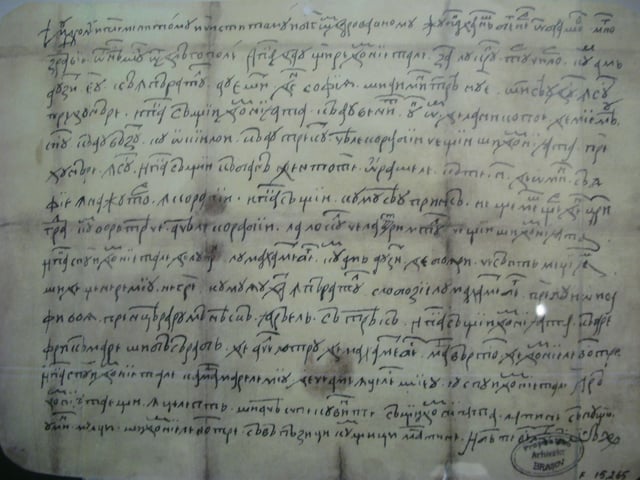
Neacșu's letter is the oldest surviving document written in Romanian

A sample of Romanian written in the Romanian Cyrillic alphabet, which was still in use in the early 19th century
The first written record about a Romance language spoken in the Middle Ages in the Balkans is from 587. A Vlach muleteer accompanying the Byzantine army noticed that the load was falling from one of the animals and shouted to a companion Torna, torna frate (meaning "Return, return brother!"), and, "sculca" (out of bed). Theophanes Confessor recorded it as part of a 6th-century military expedition by Commentiolus and Priscus against the Avars and Slovenes.[106]
The oldest surviving written text in Romanian is a letter from late June 1521,[108] in which Neacșu of Câmpulung wrote to the mayor of Brașov about an imminent attack of the Turks. It was written using the Cyrillic alphabet, like most early Romanian writings. The earliest surviving writing in Latin script was a late 16th-century Transylvanian text which was written with the Hungarian alphabet conventions.
In the 18th century, Transylvanian scholars noted the Latin origin of Romanian and adapted the Latin alphabet to the Romanian language, using some orthographic rules from Italian, recognized as Romanian's closest relative. The Cyrillic alphabet remained in (gradually decreasing) use until 1860, when Romanian writing was first officially regulated.
In the Soviet Republic of Moldova, a special version of the Cyrillic alphabet derived from the Russian version was used until 1989, when Romanian language spoken there officially returned to the Romanian Latin alphabet, although in the breakaway territory of Transnistria the Cyrillic alphabet is used to this day.[109]
Romanian alphabet
The Romanian alphabet is as follows:
K, Q, W and Y, not part of the native alphabet, were officially introduced in the Romanian alphabet in 1982 and are mostly used to write loanwords like kilogram, quasar, watt, and yoga.
The Romanian alphabet is based on the Latin script with five additional letters Ă, Â, Î, Ș, Ț
Today the Romanian alphabet is largely phonemic. However, the letters â and î both represent the same close central unrounded vowel /ɨ/. Â is used only inside words; î is used at the beginning or the end of non-compound words and in the middle of compound words. Another exception from a completely phonetic writing system is the fact that vowels and their respective semivowels are not distinguished in writing. In dictionaries the distinction is marked by separating the entry word into syllables for words containing a hiatus.
Stressed vowels also are not marked in writing, except very rarely in cases where by misplacing the stress a word might change its meaning and if the meaning is not obvious from the context.
For example, trei copíi means "three children" while trei cópii means "three copies".
Pronunciation
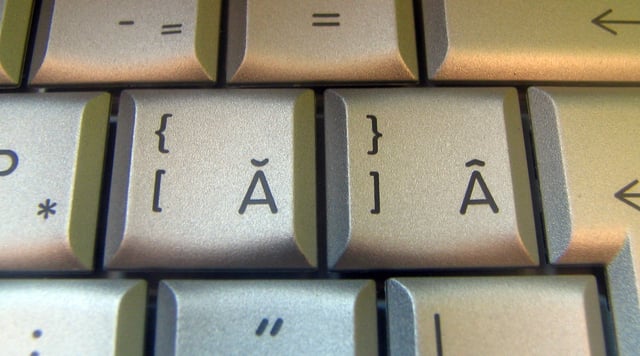
A close shot of some keys with Romanian characters on the keyboard of a laptop
h is not silent like in other Romance languages such as Spanish, Italian, Portuguese, Catalan and French, but represents the phoneme /h/, except in the digraphs ch /k/ and gh /g/ (see below)
j represents /ʒ/, as in French, Catalan or Portuguese (the sound spelled with s in the English words "vision, pleasure, treasure").
There are two letters with a comma below, Ș and Ț, which represent the sounds /ʃ/ and /t͡s/. However, the allographs with a cedilla instead of a comma, Ş and Ţ, became widespread when pre-Unicode and early Unicode character sets did not include the standard form.
A final orthographical i after a consonant often represents the palatalization of the consonant (e.g., lup /lup/ "wolf" vs. lupi /lupʲ/ "wolves") – it is not pronounced like Italian lupi (which also means "wolves"), and is an example of the Slavic influence on Romanian.
ă represents the schwa, /ə/.
î and â both represent the sound /ɨ/. In rapid speech (for example in the name of the country) the â sound may sound similar to a casual listener to the short schwa sound ă (in fact, Aromanian does merge the two, writing them ã) but careful speakers will distinguish the sound. The nearest equivalent is the vowel in the last syllable of the word roses for some English speakers. It is also roughly equivalent to European Portuguese /ɨ/, the Polish y or the Russian ы.
The letter e generally represents the mid front unrounded vowel [e], somewhat like in the English word se However, the lettereis pronounced as [je] ([j] sounds like 'y' in 'you') when it is the first letter of any form of the verba fi"to be", or of a personal pronoun, for instanceeste/jeste/ "is" andel /jel/ "he".[110][111] This addition of the semivowel /j/ does not occur in more recent loans and their derivatives, such as eră "era", electric "electric" etc. Some words (such as iepure "hare", formerly spelled epure) are now written with the initial i to indicate the semivowel.
x represents either the phoneme sequence /ks/ as in expresie = expression, or /ɡz/ as in exemplu = example, as in English.
As in Italian, the letters c and g represent the affricates /tʃ/ and /dʒ/ before i and e, and /k/ and /ɡ/ elsewhere. When /k/ and /ɡ/ are followed by vowels /e/ and /i/ (or their corresponding semivowels or the final /ʲ/) the digraphs ch and gh are used instead of c and g, as shown in the table below. Unlike Italian, however, Romanian uses ce- and ge- to write /t͡ʃ/ and /d͡ʒ/ before a back vowel instead of ci- and gi-.
| Group | Phoneme | Pronunciation | Examples |
|---|---|---|---|
| ce, ci | /tʃ/ | chinchest,cheek | cerc(circle),ceașcă(cup),cercel(earring),cină(dinner),ciocan(hammer) |
| che, chi | /k/ | kinkettle,kiss | cheie(key),chelner(waiter),chioșc(kiosk),chitară(guitar),ureche(ear) |
| ge, gi | /dʒ/ | jinjelly,jigsaw | ger(frost),gimnast(gymnast),gem(jam),girafă(giraffe),geantă(bag) |
| ghe, ghi | /ɡ/ | ginget,give | ghețar(glacier),ghid(guide),ghindă(acorn),ghidon(handle bar),stingher(lonely) |
Punctuation and capitalization
Uses of punctuation peculiar to Romanian are:
The quotation marks use the Polish format in the format „quote «inside» quote", that is, „..." for a normal quotation, and double angle symbols for a quotation inside a quotation.
Proper quotations which span multiple paragraphs do not start each paragraph with the quotation marks; one single pair of quotation marks is always used, regardless of how many paragraphs are quoted.
Dialogues are identified with quotation dashes.
The Oxford comma before "and" is considered incorrect ("red, yellow and blue" is the proper format).
Punctuation signs which follow a text in parentheses always follow the final bracket.
In titles, only the first letter of the first word is capitalized, the rest of the title using sentence capitalization (with all its rules: proper names are capitalized as usual, etc.).
Names of months and days are not capitalized (ianuarie "January", joi "Thursday").
Adjectives derived from proper names are not capitalized (Germania "Germany", but german "German").
Academy spelling recommendations
On 17 October 2016, Minister of Education Corina Fusu signed Order No.
872, adopting the revised spelling rules as recommended by the Moldovan Academy of Sciences, coming into force on the day of signing (due to be completed within two school years).
From this day, the spelling as used by institutions subordinated to the ministry of education is in line with the Romanian Academy's 1993 recommendation.
This order, however, has no application to other government institutions and neither has Law 3462 of 1989 (which provided for the means of transliterating of Cyrillic to Latin) been amended to reflect these changes; thus, these institutions, along with most Moldovans, prefer to use the spelling adopted in 1989 (when the language with Latin script became official).
Examples of Romanian Text
- All human beings are born free and equal in dignity and rights.They are endowed with reason and conscience and should act towards one another in a spirit of brotherhood.
Romanian – highlighted words were inherited directly from Latin:
- Toateființeleumanesenasclibereșiegaleîndemnitateșiîndrepturi.Elesuntînzestratecurațiuneșiconștiințășitrebuiesăsecomporteunelefațădealteleînspiritul fraternității.
Contemporary Romanian – highlighted words are French or Italian loanwords:
- Toate ființeleumanese nasclibereșiegaleîndemnitateși în drepturi.Ele sunt înzestrate curațiuneșiconștiințăși trebuie să secomporteunele față de altele înspiritulfraternității.
Romanian, excluding French and Italian loanwords – highlighted words are Slavic loanwords:
- Toate ființele omenești se nascslobodeșideopotrivăîndestoinicieși în drepturi.Ele sunt înzestrate cu înțelegere și cuget șitrebuiesă se poarte unele față de altele înduhde frățietate.
Romanian, excluding loanwords and having almost the same meaning:
- Toate ființele omenești se nasc nesupuse și asemenea în prețuire și în drepturi.Ele sunt înzestrate cu înțelegere și cuget și se cuvine să se poarte unele față de altele după firea frăției.
See also
Proto-Romanian language
Albanian-Romanian linguistic relationship
Legacy of the Roman Empire
Romanian lexis
Romanianization
Moldovan language
BABEL Speech Corpus
Moldova–Romania relations